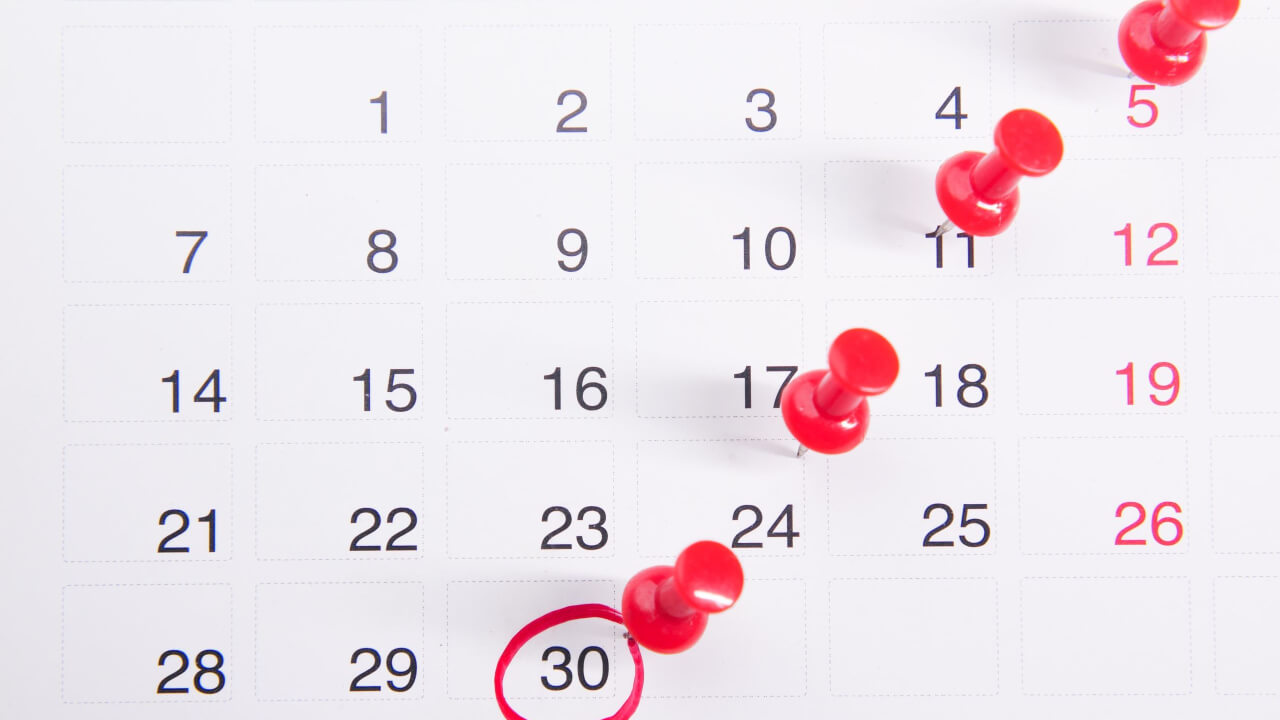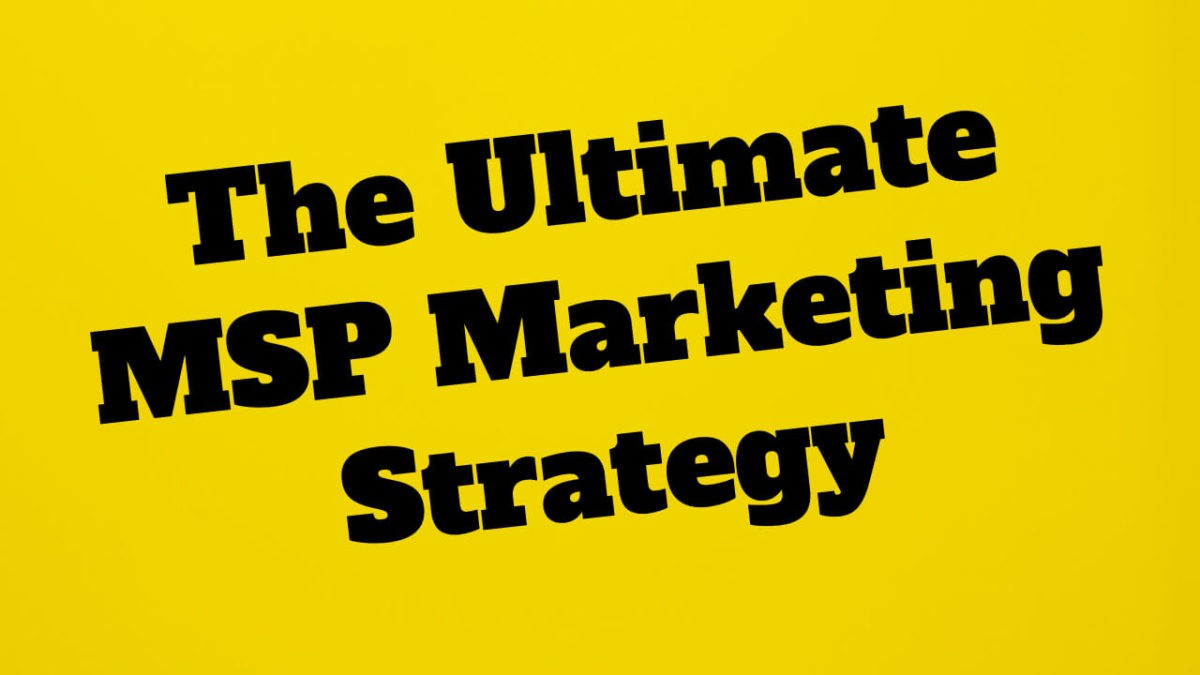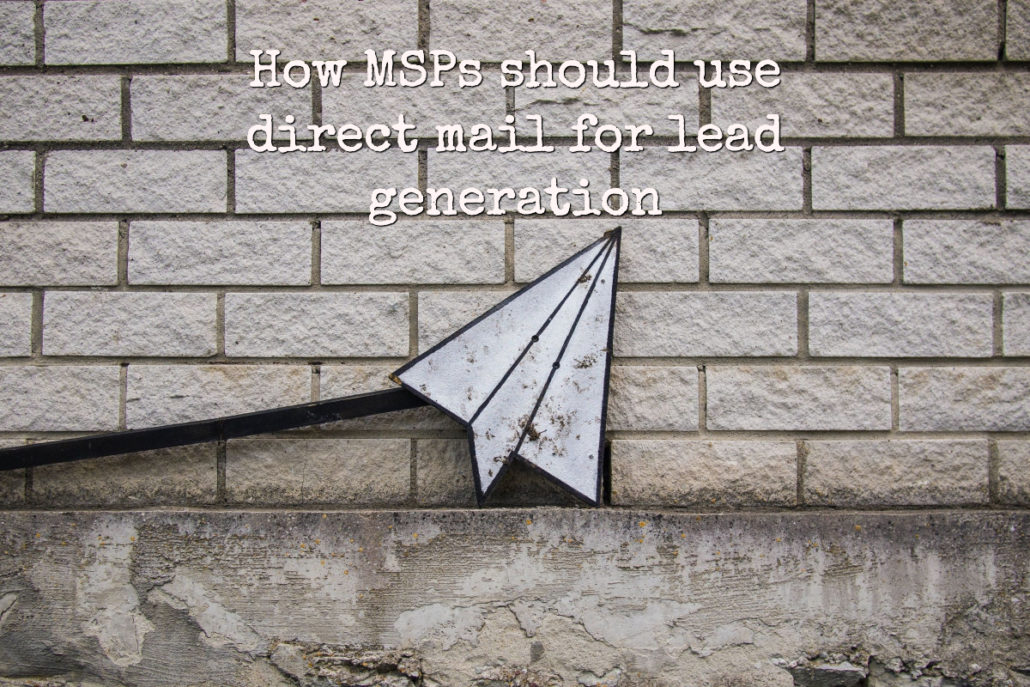This is the ultimate MSP marketing strategy to help you win new clients and upsell them: Everything you need is here
Switch off your phone, exit Teams, and liberally apply duct tape over the mouths of all your technicians... so they can't interrupt you in the critical research task you're about to undertake.
Because in this 2023 guide we're going to explore the Ultimate Marketing Strategy for MSPs.
This is no idle boast. It might have only taken a few hours to type out the words, but this guide has taken seven years to write. In that time we've been working closely with more than a thousand MSPs, helping them to generate leads, turn them into clients and then sell them more Monthly Recurring Revenue (MRR) services.
It's time to do the same for you.
We want to get you away from thinking tactically about your marketing. "Should I be doing LinkedIn" is the wrong question to ask.
Instead, let's get you thinking strategically. When you have the right strategy, the tactics are easier to choose.
In this guide, we'll cover four major areas:
- A strategy to generate more leads for your MSP
- A strategy to turn more of those leads into contracted clients
- A strategy to upsell more MRR services to existing clients
- And finally, a comprehensive list of the 63 most important marketing areas you must address
The goal here is to put in place a machine that churns out hundreds of leads for your every MSP every year, and moves people through your sales funnel. It changes them from being a suspect, to being a bonded client.
- Suspect: They are potentially interested in talking to an MSP but wary of being sold to. Literally, they are suspicious and their arms are folded!
- Lead: This is what they become once they're in one of your audiences. More on this below
- Prospect: Once you start a 121 conversation in some way they move to this stage. You'll have hundreds or thousands of leads but only a handful of prospects
- Opportunity: Not every prospect is work you'll want. If it is, then they become an opportunity
- Client: You know what this is 😃
- Bonded client: This is where they are so happy with you and your service that you're integrated into their business. Bonded clients stay for 20 years
If you can implement even 20% of what's in this guide, you will be years ahead of most of your competitors.
Duct tape ready? Let's dive in.

The 4 big MSP marketing problems
Do you know why marketing your MSP is so damn hard?
It's nothing to do with your own marketing abilities, or the fact you might consider marketing to be a distress activity (many MSPs feel that way).
No, it's more to do with the 4 unique problems you face:
Problem 1: The decision makers you want to reach don't know, what they don't know
Most ordinary business owners and managers don't understand technology at all. They think they do because they have a super computer in their pocket and know how to install new apps on it. But compared to even your first line techs, they really don't.
Think about your existing clients. How many of them could explain what the cloud is in a single sentence? How many really understand what happens during a ransomware attack (if they did know, they'd take their cyber security much more seriously, right?).
It's not just that your prospects don't know about technology... they don't know that they don't know! We call this unconscious incompetence.
It's why you must never have a technical discussion with a prospect (apart from an internal IT manager, of course - the marketing we are talking about in this guide is aimed at non-IT people). What excites you leaves them cold and bored. You must talk about the common ground that excites you both - increased productivity, efficiency and safety.
The big issue with marketing to unconscious incompetents is...
Problem 2: They make buying decisions with their hearts, not their brains
There's a weird fallacy that afflicts people who have to make frequent important decisions (such as business owners and managers). We all do it, and yet we convince ourselves that we don't.
We believe we are making important decisions based on evidence. Yet unless we are a true expert or specialist in the thing we are dealing in, most of the time we're not making a cognitive decision at all.
We're making decisions based on our feelings.
Shocker.
This is especially true for ordinary business owners and managers who are buying technology or IT support - something we have already established they don't know about.
They have no way of judging whether or not you are any good at what you do.
When the brain is asked to make a decision on something that it's actually incapable of judging, it passes the decision down to the heart. The heart makes the decision based on your feelings, and then passes it back up to the brain for a rubber stamp. This is what creates the fallacy that it's an evidence-based decision.
But this has a huge implication for your marketing. It means you are winning or not winning business based on how people feel about you, compared to what they think about you.
All your experience... your capabilities... accreditations... technical expertise... they count for very little if you don't have the ability to engage with prospects in a warm way.
Put another way - you can be the best MSP in the world. But if you can't engage with people's emotions through your marketing, you'll struggle to win clients in the first place.
Being the best at technical stuff keeps clients. Being the best at marketing wins more of them in the first place.
This is exacerbated by another problem...
Problem 3: Inertia loyalty rules
This is also known as "better the devil you know".
Inertia loyalty stops us from moving to something new, because we are too comfortable with our existing supplier. We can't see that the potential benefits outweigh the perceived hassles of moving.
A prospect will stay with their incumbent MSP - even if they have told you frequently they are no longer happy - because they are comfortable with them.
Inertia loyalty is doubly painful for something you don't understand. Business owners and managers may not understand technology, but they do understand that if it goes majorly wrong their business is SCREWED. That fear removes the desire to switch.
Can you see how inertia loyalty is a double edged sword? It's actually helping your own retention at the same time as making it difficult for you to win new clients.
There's one final problem to explore...
Problem 4: People only buy when they are ready to buy
Or put another way, the timing has to be right.
You cannot speed up the buying cycle or incentivise a prospect to make a faster decision. Because their technology is too big, too important, and too complicated for them.
Many of your prospects are actually slowing down the decision making process, to give them plenty of time to make sure they're not making a massive mistake.
Frustrating, isn't it? But remember, when you get the right prospect with the right package, you are potentially tying in a client for up to a decade, and at least six figures of revenue. It's very much worth the hassle!
Let's look at how we can overcome all of these problems with a smart, simple and proven MSP marketing strategy.

A strategy to generate more leads for your MSP
You don't want to generate leads for the sake of it. There's no point having the names and email addresses of thousands of people if none of them will ever buy from you.
You want to have lots of leads, sure. But quality over quantity should be your guiding principle. And that means starting by figuring out who you're targeting, and why.
A flippant answer to this is "anyone with a business and a wallet" 😃 Which of course isn't really true, is it?
Do you really want a 2 user business running Windows 7, and a 1982 attitude towards technology? Of course not.
Most MSPs have a very clear idea what they do and don't want. Pull together a few bullet points on this. You must write them down and keep them in front of you when you are doing any lead generation.
Your bullet points could look something like:
- Minimum 10 users (or if under 10, they are willing to pay the minimum monthly fee)
- Technology-critical business, such as a CPA (accountant), lawyer or financial professional
- Preferably they are regulated and the regulators are not slow to heavily penalise them for cyber security mistakes
- Positive, professional and modern attitude to technology. They see it as an investment in safety, flexibility, and productivity
In marketing we call this a buyer persona. Once you understand the person you are trying to reach, you can get in their mind and start to look at things from their point of view.
Get this right, and you'll be one of the best MSP marketers on the planet. We're not kidding! The ability to see things from someone else's point of view is pure gold dust. You can figure out what motivates them and therefore heavily influences the buying decisions they make.
What do they want?
What do they need?
What do they fear?
The other benefit of knowing exactly who you want to reach, is you can figure out where to go to find them.
There's a simple 3 step lead generation strategy that we've been recommending to MSPs for years. Don't be fooled by its simplicity. It's the basis of our own marketing, and is used by hundreds and hundreds of MSPs across the world.
Let's tell you what it is, then explore each step in more detail.
- Build multiple audiences
- Build a relationship with them
- Commercialize that relationship
What do we mean by building multiple audiences?
We mean groups of people who will consume your marketing. For most MSPs that will be just 2 or 3 groups.
Your connections on LinkedIn is an audience you should be building, and also your email database. These are the two basic audiences to focus on.
Other audiences you could build include:
- Other social media platforms such as Facebook or Instagram (only use platforms your target audience uses. For example today TikTok isn't used by many middle aged decision makers. Of course this could change over time)
- Your LinkedIn Newsletter
- Groups within social media, such as LinkedIn groups or Facebook groups
- Your YouTube channel
- Your printed newsletter distribution list
- Other specialist online forums for your area or vertical
- Relevant networking groups
- Associations, especially in a vertical
The general rule here is to go where your audience is. For local business owners that's on LinkedIn and networking events. In a vertical you may find yourself targeting trade associations, websites, email lists, forums, and events.
How do you then build a relationship with them?
This is done through content marketing. You send out content on a regular basis that is both educational and entertaining... we call this edutainment!
On a practical level, you can break this down into a series of content tasks that are repeated. For example:
- Daily: You post on social media
- Weekly: You send out an email
- Monthly: You ship out a printed newsletter
Remember, the goal of all this content is to start to build a relationship with your leads. Much of marketing is about being in front of the right person at exactly the right time. At the point they are sick of their incumbent MSP and are thinking of shifting, you already want to have a relationship with them, even if it's a minor one. Because the chances of them picking you go up dramatically.
Which is why proactively commercializing your relationship is the critical final step
This is about shaking the tree and seeing who falls out. The best way to do this is on the phone. You find someone to call your leads for you, and try to discover:
- Basic details of the business: Number of staff etc
- How happy are they with their incumbent supplier?
- How long is left on their contract?
This information is pure gold dust. It allows you to decide who to pursue and who to ignore - PLUS you know when to pursue them.
The overall goal is to get hot leads booked onto a 15 minute video call with you. Then you can work your magic, book a proper sales meeting with them, and take it from there.
These phone calls are NOT something you as the owner or manager of the MSP should be doing. There are much better uses of your time. And do not hire a marketing or telesales agency; they will burn through your money and leads in a matter of weeks.
No, the best way to do this is to hire a back to work Mom to do it for you. She can work remotely using your VoIP system, working just 2-3 hours a day, 2-3 days a week.
She doesn't need to know anything about technology or much about your business - and she doesn't even need experience of selling. Because this isn't a selling role. It's a relationship building role with a single clear outcome (booking that 15 minute video call).
Find a bright, bubbly person who loves chatting on the phone and finds people fascinating, and you will be onto a winner.

A strategy to turn more leads into clients
Right. If you have followed the strategy we've laid out above, you will have set up a simple but powerful MSP marketing machine.
And you now have the ability to generate leads, warm them up, and turn those leads into qualified prospects.
Most MSPs agree that once they have a meeting with a prospect, they convert that person into a client "most of the time". Thing is, one of the reasons for that is because you are mostly having meetings with people who have been referred to you by existing clients.
These are the best kind of leads you can get! Because they are enquiring hoping that you can help them and it will all work out (just as it has for their friend or contact who gave them your details).
Once you get really good at lead generation you will find yourself in front of people who aren't as ready to buy from you. Your conversion rate will drop and you'll worry you've lost your magic touch!
Not at. It's just that you need to put more work into persuading these people that they can trust you to give them what their business needs and wants, and take their fears away.
Just like all marketing, this is more of a science than it is an art. Here's a strategy you should apply to every single sales meeting. It leverages powerful marketing psychology and influences prospects towards you and away from your competitors.
Turn this into a system. Done well, this can double your results, taking you from a 1 in 3 conversation rate to a 2 in 3. Twice the results for the same amount of work? Yes please.
Pre-appointment pre-suasion
Pre-suasion is the process of influencing someone before you ask them to do something. In this case, you can influence a prospect before you sit in a sales meeting with them.
The most robust way to do this is with a case study, the most powerful of the three kinds of social proof (reviews, testimonials and case studies). The case study focuses in on a client of yours and tells a story about their journey with you. A good structure for this is:
- Relevance: Show the person who is reading the case study that this is relevant to them. For example, you would state that they are a business owner, in order to make their story relevant to other business owners
- Problem: Detail the problem they had. Don't get too technical. Talk about it more in broad business terms than in technology terms
- Poke the pain: What did this problem mean for this business? How did it hold them back? The more you poke the pain, the more powerful the case study will be
- Solution: You're the knight in shining armor! Talk about what you did to remove their problem. Again don't get technical
- Happy ending: As a result of you removing their problem, what new levels of success could they go on to?
Ideally this case study will be created by a professional writer after interviewing your client. Get it professionally designed and printed in a high quality booklet. If you have several case studies you can combine them into one book.
Imagine the power of this headline on the cover: "Here's why 5 local businesses picked XYZ IT". Wow!
Then you ship a copy of this to your prospect before your sales meeting. When you book the meeting tell them you'll be doing this, and ask for their commitment to read the case study before the meeting. Some will, some won't. The ones that do will be very excited to meet you. And whether they read it or not you will stand out from your direct competitors.
Pre-appointment practical planning
When you're busy it's very easy to intend to do important things, but never actually get round to them. When it comes to sales meetings, a simple 30 mins of planning will again stack the odds in your favour.
Create a system to ensure you do proper pre-appointment research. That means Googling your prospect, looking at their website and what else is said about them online. Make sure you also look up the person or people you are meeting. The more you know about them, the better the chance you'll make a proper connection and ultimately win their business. Certainly connect to them on LinkedIn ahead of the meeting.
There are also practical things to prepare. Where can you park for the meeting? Look at the building on Google Maps so it's familiar to you.
Should you wear a suit or be slightly more casual? Follow the lead of your prospect with this - never be less formally dressed than they are. You can actually ring their office and ask what usual work wear is.
A meeting environment for success
Where you meet and even where you sit during the sales meeting will have an effect on your success.
Sales meetings in your prospect's office are a killer. It's their space and full of their distractions - their computer, things on their desk they haven't done, and their staff knocking on the door every 5 mins.
Plus, if they sit at their desk and you sit the other side, there is a barrier between you. This is the complete opposite of what you want. It's hard to form a 20 year partnership with someone when you have such an adversarial start.
The best place to meet is a meeting room, or even a neutral environment such as a hotel or coffee shop. Make sure you sit alongside your prospect, not opposite them. This may feel weird the first time, but it's the right thing to do.
At the start check how long they have available for the meeting. Make a big thing of switching off your mobile in the hope they do the same thing. And we strongly suggest you take notes in a paper pad, or if you must use a gadget, make it a tablet in Airplane mode. A laptop is another barrier between you and them.
In person proposals
Sales meeting done... you've worked your magic... the next part of this strategy is NOT to just send them a proposal.
Instead, you want to persuade them to have a second meeting with you, when you can go through the proposal. We know there is pain in asking for this meeting and it's a bit of a time suck. But we promise you it will give better results. And you don't need to be a super slick presenter. Talking with passion about what you do is more than enough.
Try to make sure all of the decision makers are there. You can judge their thoughts and feelings by their reactions to you presenting the proposal during the meeting. And you can make sure they all fully understand why they need to invest in their business.
Impact box
An impact box is a box of stuff that you send to a prospect in order to make… an impact! The idea is to really punch through and show them that you mean business.
You send this to them with the case study before the meeting. Or perhaps with a printed copy of the proposal after the in-person proposal. Your choice.
You don’t have to spend a fortune on your box. The contents could include:
- A hand written short intro note: Hi Dave. I know that picking a new IT support company is a big decision. We’d love to partner with you. Here’s a copy of my IT Services Buyer’s Guide and some case studies, plus some snacks to enjoy while you’re reading them. If you’ve got any questions about joining us, just give me a call on…
- Your proposal or confirmation of the meeting / follow-up meeting (depending where in the sales process you send this impact box)
- Your IT Services Buyers Guide (we supply this to MSP Marketing Edge members)
- More case studies
- Some edible stuff: Chocolates, cookies, or candy. If you can find out their favourite chocolate bar, that would be powerful. Maybe a few cans of Coke, or tea bags or something
- Some merch – a mouse mat, pen, whatever really
Make sure the box looks nice inside. Use sheets of gently crumpled tissue paper to achieve that. On the outside you could have some stickers printed with your logo.
Whatever packaging materials you use, make sure they are fully recyclable. This is increasingly important to people, making it something you must be aware of and comply with.
Scheduled follow-up
Final step of this strategy is to reduce the need for you to "chase" your prospect for their decision.
Everyone hates this, both the chasers and the prospects!
So instead, jointly agree when you are going to call them for a decision and put it on your calendars. Make sure to send a calendar invite and confirmation email to them. You'll find that if they can't make that call for any reason most people will contact you to reschedule. Perfect.

A strategy to sell more Monthly Recurring Revenue (MRR) to existing clients
Lead gen? Sorted.
System for successful sales? Sorted.
Next up, it's the marketing strategy to sell more MRR to your existing clients. And the exciting news is that this is the most profitable strategy.
You see, there are only three ways to grow your MSP:
- Get more new clients
- Get those clients to buy from you more often
- Get those clients to spend more every time they buy
Everything we've written about so far has been to get new clients. Yet new clients are expensive. You have to invest hundreds of hours and often thousands of dollars or pounds to win them.
Sure, you need new clients. but you mustn't ever believe that effective MSP marketing comes just from chasing new clients. There's easier - and dramatically more profitable - revenue to be won by selling more to your existing clients.
What we're going to recommend here covers off selling more to them, and getting them to spend more. It's another three step strategy that looks simple, but is bulging with power:
- Use the profit matrix
- Do strategic reviews
- Commit to technology roadmaps
The profit matrix
The purpose of this matrix is to give you an immediate visual snapshot of which of your clients are not buying which services.
Yes, this is info in your PSA. But it has less value there, compared to when it is pulled out and assembled in one place.
The profit matrix works best when it is done physically in real life and not on a screen. You might choose to use a whiteboard, or maybe even a flip chart.
Draw a simple grid. Down the left side list your clients. Across the top list your MRR services.
Then, fill in the grid. Mark a dot where someone is buying a service (little magnetic markers on a whiteboard look cool for this). Create a system to update this info once a week so it's always up-to-date.
Make sure that your matrix sits in front of your desk; ideally somewhere your techs can see it.
You'll find yourself staring at it, mentally making connections, wondering "why doesn't that client buy that service". It has its greatest value in the days before you do a strategic review - we're coming to that in a few moments.
When your techs can see the profit matrix as well, it can help them to help your clients better. They can look up at the matrix and think "this is the third time I've had this client on the phone with this problem... if they bought xyz service it would eliminate the problem." Few techs would act on that with the client. But if you can train them to drop you an email when they have these realizations, you can do the heavy lifting (and you pocket the MRR anyway).
Strategic reviews
These have different names in different places – Quarterly Business Reviews (QBRs); technology reviews… it doesn’t matter what you call them, because the purpose is the same.
So far as your client is concerned, this is a high level, big picture exploration of their business and their technology in the future.
And that’s what makes this review so powerful.
The beauty of looking at the future of someone’s business is that you can ask them questions that set up sales. And because you’re their strategic advisor, they will see this as value add, not selling.
- What’s it going to take to make that happen?
- What part will technology play in that?
- What’s the best case scenario here?
- What’s the worst that can happen?
- What will you need from your staff to make this happen?
- What do you think will hold you back?
- How could a cyber security incident affect this?
Can you see the power in asking those questions (or your version of them)? Imagine your client sitting there, thinking about the future, going quiet as they realize their technology is not setup correctly for future growth… and they ask you “what's the best way to fix this?”.
This is the ultimate form of selling! Where the client is asking you to buy, not the other way round. It's upselling with increased respect and retention built in.
Here are 10 practical actions to help you start implementing your strategic reviews:
- Don’t try to do this with every client. Start with your most important clients, or those with the most potential
- Get it clear in your mind you will do this once a year. The reason we don’t call these Quarterly Business Reviews is because 4x a year is overkill for all but the very biggest or fastest clients
- Drop them an email inviting them for lunch to complete a strategic technology review on their business. No cost, it’s all part of the service. Send your live calendar and expect to have to chase them by phone to get this first one booked in
- Do not do this in your office or theirs. Too many distractions. Take them to a locally owned restaurant for lunch. This buys you an hour of their time (and eating together builds relationships, anyway). Reserve a table at the back and seat them with their back to the other diners so they are focused fully on you
- Neither of you should drink alcohol. Put your mobiles on DND, face down on the table. Take notes in a paper pad. If you must use technology, use a tablet, but disconnected from the internet. A laptop screen is a barrier between you and them
- Set the context for what you want to talk about. This is the most important technology meeting of the year. You want to look at their plans for the next 3 years and ensure short-term technology decisions set up long-term success
- If there have been any support issues recently, make sure they are all sorted out before this meeting. Mention them so they’re not the elephant in the room, but then switch the conversation to the future. If your client uses this meeting to beat you up about problems, it’s a wasted hour
- Use open questions to get them talking about the future of their business. Like any good sales meeting, they should be talking for 80% of the meeting
- No overt selling required! In half your meetings or more, opportunities to sell them projects or MRR services will just present themselves. Get a commitment at the meeting, or if it needs a quote or proposal, then make sure to send that over within 24 hours. Diarize when you are going to call them to get their acceptance
- At the end of the strategic review, book the date for the next one. Literally, pull out your calendars and pencil in a date. Even if it’s a year away, you have a confirmed action in the calendar
Technology roadmaps
The final part of this is getting your client to readily make a real long-term commitment to you. Your greatest weapon for this is a technology roadmap.
It's a document that lays out what technology changes and investment your client is going to make in the years ahead. You build it together based on the long-term thinking you've done together during the strategic review.
And the beautiful thing is that you ask them to effectively sign it off and make a long-term commitment to it, They're not legally contracted, but they are emotionally committed.
Done well, this roadmap will positively affect their:
- Attitude towards investing in their business's technology
- Respect for you as their strategic advisor
- Desire to stay with your MSP
Plus, they may formally budget for anticipated tech spend. And you can plan your technician resources as you will know what projects are coming up and when... great!

63 item action list: Tackle your MSP's marketing in this order
Well done, you made it this far. You now have all the marketing strategies you need to generate leads, turn those leads into clients, and then upsell your clients.
We want to make sure this is the most comprehensive and useful MSP marketing guide you will find on the interweb. So here are the most important marketing areas for your MSP. If you're starting from scratch, these are the areas you need to make sure you're on top of.
We've listed them in the order you should tackle them. Start at the beginning and work your way through. That'll keep you busy for a few months...
Ready? Let's go
😃
Part A: Marketing basics
Strategy, structure, and setup
1) Lock 60 to 90 minutes a day to work ON your business
You're fooling yourself if you think business growth will happen without proper resourcing. As the owner or manager of the MSP, you have to give it enough of your most valuable resource: Your time. The most reliable way to make this happen is to find 90 minutes a day to work ON the business. That means activities that win you more new clients, get them to buy more or spend more. Try to find the same 90 mins every day to make this a positive habit, and find the right environment where you can work without being interrupted by anything,
2) Understand the 4 big marketing problems
The ordinary decision makers you want to reach don't know what they don't know about technology. This means they can't assess whether or not your MSP is any good at what it does. Their brain doesn't have enough information to make a buying decision... so delegates the decision to the heart. This means they are picking your MSP or not picking it, based on whether they like you or not.
Now you know why it's so important to build a relationship with them. They are also overly swayed by inertia loyalty, where it seems safer to stay with an existing provider than switch to a new one (even if they're not happy with the incumbent). The final problem is about timing - people only buy when they're ready to buy. You can't speed this up, and have to be in front of them at that exact moment.
3) Understand the 3 step marketing strategy
To tackle the 4 big marketing problems, you can use the 3 step marketing strategy. This involves building multiple audiences of people to listen to you (start with LinkedIn and your email list). Then build a relationship with them through content marketing (daily post on social media, weekly send an edutainment email, and monthly ship a printed newsletter). Finally you commercialize the relationship by finding a back to work Mom to phone your audiences, continuing to build the relationship for you while also spotting who might be ready to talk about swapping MSPs, and when.
4) Find your DOA resources
We've all seen enough medical dramas to know that DOA = Dead On Arrival. Well, that's what you'll be if you keep trying to do everything yourself 😃 Instead you should Delegate, Outsource and Automate. This means passing as much of your day to day work as you can onto your staff and talented freelancers - and especially marketing work. Do it a few times to build a system. then let others do it for you. The rule to live by is this: You should only do, what only you can do.
5) Who is your prospect? (buyer persona)
The best marketing comes from understanding the person you are trying to reach and speaking directly to them. You need to understand their needs, wants, hopes and fears. This can be done formally to build something called a buyer persona. You build up a character who represents your target buyer. Give your character a name and bring them to life! Then, you can test all messaging, ideas and marketing initiatives against their likely response to it.
6) Get in the mind of your prospect
Take the buyer persona to the next level. Act in the way they act to deepen your understanding. Read the books and digital media they read. Subscribe to their trade news. Attend the events they attend. The more you hang out in their world, the better you will understand them, and the easier you will find it to influence them.
7) Find your easy niche or vertical
Getting this right is total marketing dynamite. When you pick a vertical and commit yourself to it, you open the opportunity make your marketing easier and overall business more profitable. Why? Because marketing within a niche makes you more relevant and desirable at the same time. The best clients will always be willing to pay more for perceived experts in their field. It feels less risky to them.
You can run a niche alongside your general clients. Start by picking a type of business you currently enjoy working with and want more of. Create a case study and make that the heart of a new website (not just a page on your existing site; that's lazy). Ensure the new site talks only to your niche. The tighter the message, the more successful it will be. If you choose to marry the market - to go "all in" on that niche - you could dominate it within 3 years. Seriously. We've seen this happen to MSPs a few times. But you need to make the long-term commitment.
8) What makes you different?
Why should I buy from your MSP and not one of the thousands of others? What makes you better for my business? All prospects are asking this even if they're not saying it out loud. Yet few MSPs have the answer. And there's no point talking your tech stack or superior systems, because technical things don't influence ordinary people. No, the answer is based around you and your people. The only true thing that can't be copied in your business is YOU. Make yourself the face of the business so people are buying you and your team. It's the greatest and most unbeatable differentiator you have.
9) Obsessively collect social proof
Social proof is the concept that most people, most of the time, act like sheep and prefer to do what other people are doing. This a deep psychological drive within us, which kept us alive back when we lived in caves and were in the middle of the food chain. You should be collecting social proof from happy clients all the time. The best time to ask is after their first 90 days, or at the successful completion of a project, or when you have solved a big problem. The three primary forms of social proof are:
- Reviews: Endorsements on a third party platform you can't control (which makes them more powerful)
- Testimonials: Endorsements you do control
- Case studies: An in-depth deep dive into a client or subject, told in a specific story-like format:
- Show the story is relevant to the viewer or reader
- Say what problem they had
- Poke the pain of the problem
- Show what you did to remove the problem
- Explore how that gave them a happy ending

Website
10) Get the basics right
Your website is your single most important digital marketing asset. It deserves a one off investment of time and cash to get it right, and then revisit it every 3 to 6 months to make tweaks improvements. Importantly, your website must talk to prospects more at an emotional level than a cognitive one. They're choosing you (or not) based on their feelings towards you. Make sure the site content is focused more on the prospect than on you. Have a consistent look and feel to every page. Make sure everything is where it's supposed to be: Logo top left corner; contact us on the furthest right in the navigation; and about us page just to the left of it. And make sure the site overall looks and feels up-to-date in its theme and content.
11) Review the home page
A great home page has these elements, in this order:
- Attention grabbing headline: "1,058 TownName people trust us with their technology. You should join them"
- An intro video featuring you and clients
- Photo of you and/or your team, with a caption
- Small amount of intro text focused on the benefit the prospect gets from talking to you
- Some testimonials. The best ones are screenshots of independent reviews, with a link to the reviews platform
- A Call To Action (CTA - more on this below)
- Some more text about your business, linked to your about us page
- 2 or 3 case study videos from clients
- Something they can download, such as an IT Services Buyers Guide
- Details of 2 or 3 of your core services
- Highlights from your blog
- Another CTA
12) Review the about us page
The two pages that get the most traffic on most MSPs' websites are the home page and about us pages. You should think of them as your core selling pages and give them 80% of your attention and resource. They should also contain interchangeable elements. That means you need videos, social proof and details about your people on your about us page. Let's see people smiling and having fun! This is more interesting than a dry timeline of your business, or boring text about what you do and who you do it for. Links to in-depth case studies as web pages or PDFs also fit well on an about us page. And don't forget to include a CTA - ideally twice if it's a long page.
13) Setup a weekly blog
One of the things that tells a prospect that a business is up-to-date and an authority in its field is when it publishes regular content, at least once a week. There are also Search Engine Optimization (SEO) benefits of doing this, as the more often Google finds new content on your site, the more often its automated robots will visit your site to check. Find a way to post new weekly content. You might commission a writer on Upwork or Fiverr; or use an AI writer such as Jasper and edit the content; or use a service such as our MSP Marketing Edge, where you get a fresh blog article and related video (presented by a live female presenter) every week.
14) The most powerful CTA
A CTA is the Call To Action, or the thing you most want prospects to do when they are visiting your website. There are lots you could use including asking people to live chat, phone you, send an email, fill in a form or connect on LinkedIn. We've found the best CTA right now is to embed your live calendar into the website so prospects can book a 15 minute video call with you, on a day and time that suits you both. Use Calendly or Microsoft Bookings for this. This is a high enough commitment to get rid of most timewasters, but low enough for genuine prospects to book in.
Don't be surprised if you end up having 30 to 40 minute conversation with people about their businesses. In fact, set up rules in Calendly that prevent any other calendar entries for 45 mins after these appointments. Your job on these video calls is to get a proper sales meeting booked with them.
15) People, people, people
Understand this - in B2B sales, people buy from people. Big brands and well known business names affect the decision, sure. But primarily they are buying you and your team and what you can do for them. This starts right from the moment they are on your website. If your site is like most MSPs and has no real people on it at all (stock images really don't count), you're dramatically reducing the chance of them contacting you. If you're a one person band, you can still be the face of the business. If you have staff then tell them they need to be in the marketing if they want a pay rise (we're not joking). Wedding photographers can be a great way to get decent photos done easily, as they are often kicking around with nothing to do mid-week, so might do you a deal for a quick shoot.
16) Videos, videos, videos
Better than a photo of you and your team would be a video. This is a more expensive and time consuming option, but you will get a better long-term return from it. Video is everything these days: Our training, our communication; our entertainment. The time to endorse video was yesterday. Just do it. Also, here are some great examples of MSP videos (show them to your preferred video person and say "do me one like this")
17) Pricing calculator and interactive tools
The more prospects engage with you, the more likely they are to enquire to you. There are some simple tools you should put on your website, starting with a pricing calculator (this is the best explanation you'll ever hear for why this is so critical). Other interactive tools you could use include a downtime cost calculator, a password strength checker, a random password generator, and the ability for prospects to check if their email address has been breached.
18) IT services buyer’s guide
No-one but the hottest prospects will be interested in this. What is it? A guide about how to buy what you sell. You teach uneducated business owners and managers what makes a good MSP and what they should avoid. Of course, you take all of the things you do well and tell them to look for those things! This must not be too techy, but rather focused on helping them find the things they are most looking for - peace of mind, increased productivity, fewer staff whinges. Don't put this guide behind any kind of gate. Let anyone download it and access the PDF instantly. You could also do an enormous HTML page version of it. So long as that's your original content, that will index very well in search engines.
19) Data capture
This is less relevant today than in years gone by, but if you get good traffic to your website, it could be worth looking at. Data capture is the process of getting someone to choose to join your email list. They're not going to do it for your newsletter as they really don't want more spam. But they might do it in order to get an "ethical bribe"; something they get in return for entering their email address. A book, guide or report can be useful ethical bribes. Also look at engagement tools such as quizzes. These wrap engagement and data capture into one parcel.

20) Photo
Remember that photo shoot you did with a wedding photographer for your website? That's where your new LinkedIn profile shot comes from. This photo is very important. It must represent what you look like today (a thinner younger version of you is tempting 😃 but could be perceived emotionally as 'untruthful' when they jump on a video call with you). Get a great photo taken by a professional, make sure you're smiling, and use it across all your marketing materials. Then update it every 2 years.
21) Headline and profile
There are three types of headline you can use on your LinkedIn. A credibility positioner works well (our founder Paul Green uses this on his LinkedIn). A better alternative is to write your headline from the point of view of the prospect. Talk about what you can do for them, or what problem you solve. You have 200 characters to work with. We don't recommend you use the pipe symbol (this one | ) to squeeze more into your headline. That can make it hard to read. Sometimes, less is more.
You can also use this headline across other marketing, such as your business card. That kind of marketing consistency makes you feel more trustworthy at an emotional level. Fill in as much of the rest of your profile as you can. Like all social media platforms, if LinkedIn wants it, give it to it... there are bound to be algorithmic advantages.
22) Set up LinkedIn Newsletters
LinkedIn has changed a few times in its existence. It started as the online record of your offline connections. Then under Microsoft's stewardship it became THE social network for business, and essentially a business version of Facebook. Now there's a new phase, where content is more important than ever before. In fact, you can switch on creator mode to tell LinkedIn you are committed to creating content on the platform. This makes a few changes to your account; the biggest being that people can follow your content without having to be connected to you. It also switches on new toys for you.
LinkedIn Live allows you to broadcast live on the platform, and LinkedIn Newsletters allows you to build a new audience of subscribers. It takes 20 mins to set up (Google it). We suggest you make a commitment to a weekly newsletter. Although its not really a newsletter in the traditional sense of pulling together lots of content. LinkedIn Newsletters is just a wrapper for the articles you can write on Linked.
Here's the exciting bit though... the algorithm will work hard to get people to subscribe to your newsletter. And when you write a new one, not only do they see it in their news feed, but LinkedIn will email a copy to them too. This makes building a new audience and building a relationship with it too easy. You really should do this. But if you make a commitment to sending a weekly newsletter, make sure you actually do it.

Email list
23) Pick a CRM
Your CRM, or Customer Relationship Manager, is the key tool to email your database of prospects. Your PSA is not the right tool for this (use that to email your clients). There are dozens of different CRMs available. In our experience, lots of MSPs pick a CRM thinking they'll use all the bells and whistles... but then they don't. So, ask yourself in advance whether you will just use this to send the odd email to prospects, or whether you will really make the most of automation campaigns and integrations with other marketing platforms. The cheap and simple CRMs to look at are Mailchimp and MailerLite. ActiveCampaign is a popular choice for MSPs - it has very good functionality for the price.
Here, we use Keap, although mostly because it drives all our automation and the thought of migrating makes our chief developer's eye start twitching. The Queen of all CRMs right now is HubSpot. An amazing toolset, but expensive... they will want one of your kidneys in return.
24) Back of the couch data gather
Got no-one to email? Not true. If you've been in business for a couple of years or more, you have a ton of data to email; it's just not collected together into your CRM. You need to go on a hunt for it; the equivalent of putting your hand down the back of the data couch. Look for every email you ever had from any prospect. Every form filled in. Every live chat. Notes from every call. Every business card ever thrust into your hand. Gather all this data together and add it to your CRM. Exclude people who are active clients but include lapsed clients (you never know when they will want to come back). And then start emailing these people with your weekly edutainment email.
Please don't overthink this data. The first couple of times you send emails, you'll get some unsubscriptions and annoyed replies from idiots. Ignore them. From email 3 or 4 onwards you have a working email database. Yay! And don't worry too much about your local anti-spam laws. They were designed to stop the million email a day Viagra spammers; not a genuine local business from emailing other local businesses about subjects they may have legitimate interest in (not legal advice 😃).
25) Set up data capture
As mentioned above, data capture on your website is harder than ever before, and fewer people are willing to do it. If you have the spare marketing resource capacity then it's a one off job to put in on your website. Use an ethical bribe such as a book they get in return for joining your mailing list, or better use some kind of quiz to get them engaged. If you don't have any spare marketing capacity then ignore this for now.
26) Systemize email address acquisition
Whereas this is one you must do. Once you have your CRM set up and a system to send out a weekly edutainment email, you must keep building your email list. It will degrade over time as people become disengaged and stop reading your emails, or just plain unsubscribe. You can set up a simple system so any contact with any prospect harvests their email address and adds it to the CRM. This is easy to automate with web forms and Zapier.
The harder system is the human one. Every time any member of your team talks to anyone who is not a client they must get the email address and have a simple place to enter it. Especially people met in real life, where relationships can be built faster. Again, don't overthink adding people to your database without overtly asking them. Of course a few whingers will complain about it. Forget them. Focus on the vast majority of prospects who don't mind or notice that you've done it.

Your MSP’s marketing system
27) Daily: Make LinkedIn connections
OK... now we're getting into the really exciting stuff. If you are utterly determined to grow your MSP into a valuable asset that gives you the lifestyle you crave the most, then you must operate the business with purpose. And that means systemizing EVERYTHING. Not just the technical work, but the marketing as well. We suggest a series of regular actions that are systemized for someone else (not you) to do in the business every day, week and month. Doing this well on a regular basis is what creates the marketing machine you need and want.
The first daily task is to attempt up to 10 new connections on LinkedIn every day. This is so easy it hurts. Either decide what kind of business owner you want to work with and go look for them (i.e. CPAs (accountants), lawyers, manufacturers etc). Or better still, find someone who is already connected to the people you want to reach, connect with them, and then connect with their connections. Every town has an uber-networker who will have a decades worth of contacts on LinkedIn. Great. They've done a chunk of the hard work for you. If you have a substantial LinkedIn list and you want to stop this happening to you, there is a setting you can toggle to hide your connections (just Google this).
28) Daily: Post and comment on LinkedIn
Social media is so disposable that you have to post regularly in order to stand out. Once a day is perfect (in fact, posting more than once in a 24 hour period can cannibalize your own views. Canned content supplied by vendors or specialist MSP marketing services is better than no content. Although that is beaten by your own content. We recommend you use canned content to ensure you post every day, and on the days you are inspired to create your own content, don't post the canned stuff.
Be creative with your posts. Try new things and formats (photo, video, slideshow etc) to see what gets the best engagement and then do more of that. Be aware the algorithm will change regularly. It's also important to comment on other people's posts. Take 10 to 15 mins to scroll through your feed and add comments where they are relevant or add value. This is a great way for new people to stumble across you. Just make sure to set a timer so you don't waste an hour of your life on it!
29) Daily: Post on other social media
There are so many social media platforms to choose from. At time of writing (January 2023) we recommend you focus your attention on LinkedIn, Facebook and YouTube (in that order). Instagram is useful if you are targeting businesses that use it for their own marketing (such as retail, restaurants and hospitality). Twitter is just too volatile right now, so only use that if you are already a committed Twitfan. TikTok is huge but barely used among your target audience (middle aged decision makers)... for now. Let's see what happens. Any other cool new platform can be safely ignored until it reaches a mass audience, and is noticed by that audience. That takes time. Our phones are littered with "the hot new app" that 6 months on we barely remember (we're looking at you, Clubhouse).
30) Daily: Follow-up phone calls
This is the critical step that separates MSPs that rely on hope for their marketing, from those who know they are going to find the right people to speak to at exactly the right time. You find a warm, friendly and engaging back to work Mom to work 2-3 hours a day, 2-3 days a week, probably from home and around school hours. She doesn't need to know anything about technology or your business. Her job is to phone people in your audience and engage with them. And ideally achieve one of these most desired outcomes, in this priority order:
- Book a 15 minute video call with you
- Identify the point the prospect is likely to review their IT support company (and document this for a future call)
- Build the relationship between you and them, to be leveraged in the future
31) Weekly: LinkedIn Newsletter
Now we get into the weekly tasks. As mentioned above, LinkedIn Newsletters are a way to build a second audience on LinkedIn, and get the platform to send emails to them. What's not to like? It's really really important that you send out your LinkedIn Newsletter on a weekly basis. There's no evidence to back this up yet, but it makes sense the algorithm rewards people who send out their newsletter on the schedule they commit to. Also, make sure the content is edutainment. This is not a platform for selling. Come to think of it, nowhere on social media should you be selling. They are all relationship-building platforms.
32) Weekly: Send an edutainment email
Once you've got your CRM and database established (see above) then you need to send out an edutainment email at least once a week. This is not too often. You could send two a week and that would be OK, so long as the content was good enough. Your open rate will be dictated by their relationship with your name (send it from a person not a business) and the quality of the subject line. It's a fine line between intriguing (good) and clickbait (bad).
Best practice is to tease the content in the email and get them to click through to read it, ideally as a blog post on your website. This is a solid way to drive traffic to your website. You can also see from clicks who your most engaged prospects are. If you install the Facebook and LinkedIn pixels in your website, you can do remarketing to these people. More on this later.
By the way, it's perfectly OK - and in fact encouraged - to use the same content for your weekly LinkedIn Newsletter and weekly email. Just copy the whole blog post into your LinkedIn Newsletter. And make sure you post it on a different day to when you send out your email.
33) Monthly: Ship a printed newsletter
In our digital world, printed stuff has ENORMOUS value. And is desperately underused by most MSPs. When you send something physical they hold in their hands, nothing but good things happen. The brain makes better memory and reasoning connections when you hold something compared to seeing it on a screen. They are more likely to read it (you can invade their toilet time). Your printed material is more likely to be kept around for months or years, and handed to other people in the business (hopefully they've washed their hands first).
There's hassle and expense in doing a printed newsletter. We'd suggest sending it to your top 25 to 50 hottest leads and prospects every month. If that's too much then do it every other month. There is no better tool to differentiate you from all the other MSPs and keep you top of mind, amongst people who could switch MSP some point in the future. We provide a ready to use printed newsletter to the members of our MSP Marketing Edge every month.

Weekly lead generation campaign
34) Pick 50 targets a week
If you've implemented most of what we've talked about so far then well done - you are already ahead of 80% of most MSPs. We're serious. There are so few that get their marketing basics completed. Now that you have good fundamentals (website and LinkedIn) and a regular digital presence, it's time to start proactively targeted prospects with a multi-touchpoint campaign.
You're going to send the same message to them across different platforms. The goal here remains the same - to find good qualified prospects, get them to listen to you, build a relationship with them, and then find when the time is right to have a serious conversation with them. A campaign is a systemized way of doing that.
But it must be a system. If you do this twice a year you'll get "meh" results. This works best when you do it every single week. That means picking 50 people to target every week (50 is an average figure; you want as many as your phone person can follow-up in a week. No more, no less). These people can be a mix of those in your existing audiences (campaigns work better when they already have a light relationship with you) and people from cold data. More on that later.
35) Send a sales letter
Direct mail is gorgeous. Just like printed newsletters (see above) it has the power of being physical, which means it cuts through in a way digital stuff just can't. So, you start your multi-touchpoint campaign with a sales letter. There are an almost infinite number of things you can do and formats you can use. Direct mail marketing pre-dates internet marketing, and there are tons of ideas out there for you to Google.
We recommend you keep it relatively simple. Pull together a 4 page sales letter (tabloid folded to letter size, or A3 folded to A4). Catch their attention with the headline, then write some text that's about them and not you (for example you might ask them what level of support they are getting from their current IT support company). The middle pages can be filled with a case study or reviews/testimonials. This abundance of social proof shows how safe you are. And then make the back page a Call To Action - send them to a simple URL to access your live calendar for a 15 min video call. Few people will actually do this, but that's not the point. It's an important part of the overall campaign process.
Post this out every week to make the timing easy for your phone person. For example, you might post these every Friday so your phone person can start calling on Tuesdays. A few pointers we've learned over the years...
- For your call to action, consider a short vanity URL that's easy to type in, that redirects to a longer URL. And use a QR code
- Your logo goes at the bottom of the last page, not the top of the first page. Unless you have the brand awareness of Apple (you don't), your logo is the least influential part of the letter and so the least important
- Post your sales letter in a brightly coloured envelope for impact
- Use a real stamp rather than franked mail. Makes it look more real
- And for maximum impact, get someone to handwrite the envelope. You could also sign the letters yourself. These little touches take a little time but deliver a huge impact
36) Send a short email campaign
This campaign runs alongside your direct mail and is designed to build up the overall importance of your communications in their hearts and minds. Send the first email the day the sales letter arrives. Its content should ask whether they've had the letter yet. Then a day later, you can "forward" that email to ask whether they've had chance to have a read of it yet. In both these emails you'd include a link to your live calendar. Then you have an email to send if your phone person hasn't been able to get hold of them. And a final email asking them if they want to talk to you - say they can just hit reply and answer YES or NO. Now and again you'll get a yes, which is an indicator of interest.
37) LinkedIn messaging
You can do a version of this messaging on LinkedIn as well. Don't send so many messages as they stack up in LinkedIn, and some people don't check their messages for weeks on end. Perhaps just send the first message asking if they got the letter, and maybe a message on behalf of your phone person if they can't get hold of them.
38) Telephone person to call
This is one of the core responsibilities of your back to work Mom, as discussed earlier. The advantage of running the campaign before asking her to call, is that she has a reason to call people. In our experience, that can make a huge difference as it gives her role purpose, rather than just being a general "hey, call these people".

Part B: Sales
Setup a sales system for success
39) Pre-appointment pre-suasion
This is the point where marketing has done its job and sales takes over. And it's also the point where many MSPs say "ooh yes, I'm good at this bit. You give me the appointments and I'll turn them into clients". But no matter how good you are at sales, there are systems you can build to swing the odds of you winning the business more dramatically in your favor. No point in leaving anything to chance, right? This starts with influencing them before the sales meeting, also known as pre-suasion. Send a professionally written and designed case study printed in a high quality booklet. And ask for their commitment to read it before the meeting. This gets your social proof working even harder for you.
40) Pre-appointment practical planning
Make sure you fully research your prospect before the meeting. That means studying their website as well as their overall digital footprint (aka Google them). Look up the people you're meeting with and connect to them on LinkedIn. It's also worth research some basics before you meet, such as where you can park, what their building looks like and how the people you're meeting usually dress (if they're in suits and you turn up in jeans, that's not good).
41) A meeting environment for success
Don't let your prospect meet with you in their office. There are too many distractions surrounding them, and it's "their" environment. Plus their desk can be a barrier between you. For the start of a 20 year-long partnership, you really need to meet in a more neutral environment. A meeting room is OK, or a hotel lounge. Try to sit next to your prospect rather than opposite them. Don't forget to check for any time limitations they may have; make sure you both put your phones on Do Not Disturb; and take notes in a pad rather than on a laptop. Use a tablet if you must, but technology can be a barrier in a sales meeting. The process of typing up handwritten notes after a meeting can be a great way of reviewing what gold dust information the prospect has given you.
42) In person proposals
You've got to this point and could be throwing away the sale if you just send them over an email with your proposal. It would be more powerful to book in another meeting to take them through every aspect of what you've put together and why. This is how to guarantee they understand everything and can see the value, before you hit them with their investment. Many prospects will fight the need for this meeting and you may feel they are a time suck as well, but trust us - they will help you cut through the competitive mess of the sales process, and show that you are truly committed to them.
43) Impact box
If you really want to differentiate yourself from the other MSPs, send them an impact box. This is a crate of things you ship to them either as part of your pre-suasion, or with the printed proposal if you choose not to have an in-person meeting. Enclose some printed materials such as an IT Services Buyers Guide and case studies; some merch such as a printed mug or pen, some edible goodies, and a handwritten note from you. Make sure the packaging reflects the quality of what's inside but can also be fully recycled.
44) Scheduled follow-up
Nothing's worse than calling a prospect 5 times to get their thoughts on the proposal... but they don't answer your calls and ignore your voicemails. At what point do you cross the line between 'keen' and "annoying'? You can eliminate this by scheduling a follow-up with your prospect. Ask them how long they need to consider your proposal, and schedule a specific day and time for you to call them to answer their final questions and get their decision.
Confirm this by email, a letter shipped to them (that will cut through) and of course a calendar invitation. You'll be surprised how many prospects will agree to this (they hate follow-up calls too), and most will proactively reschedule this call with you if they're not available at the time you originally agreed.

Part C: Retention and upselling
90 day onboarding honeymoon
45) Face to face meeting
Hooray! You got a new client. Fist bump 😃
Now, we're not experts at delivering what you do to clients, so we don't have a great deal to write here. But we do know one thing... what happens in the first 90 days affects what happens in the next 10 years. Put another way, you have a 90 day honeymoon period with your new client in which to truly connect with them, and set up a decades long relationship.
Rightly or wrongly, we believe you should start on day one with a face to face meeting. Your future support may be fully remote, but you can explain that you prefer your onboarding to start in person. Why? Because Covid taught us that we build stronger relationships faster when we are physically together. You might even take the chance for every member of your team to visit their premises, if only to say hello to every member of their team. This might take a few days to happen and could create a lot of hassle, but it's a powerful thing to do.
46) Delight the staff
Whether you have that face to face meeting or not, you can certainly put in place a system for delighting the staff of your new client. Why focus on the staff and not the decision makers? Because many owners and managers will ask their teams what they think of the new IT people within the first couple of weeks. You want them to be bombarded with an overwhelming wall of positivity and love about you.
Three easy ways to do this. The first is a "problems amnesty". In the first week, ask all of the staff to tell you about every tiny little problem that's bothering them. All the things that their old IT support firm didn't quite fix properly. All the small things they never got round to reporting. Encourage them to tell you about EVERYTHING (yes, even the printer problems 😬). Then... you fix them. Every single one. Not only does this create a clean slate to start with, but it makes all of the staff feel GREAT about you. Good work... you just bought a ton of goodwill. You'll be glad of that in the years ahead.
Second thing you should do is put support stickers on all their computers and any other devices. Make sure they know exactly how to contact you (and not the previous guys) when there's an issue. Finally - and this is the oldest trick in the book - bribe them. This can be as simple as taking in a ton of candy for them to share. Or do something memorable, such as getting a large cake made with a message to them iced onto the top. A simple personalized gift they'll all comment on as they're helping themselves to a second slice...

Upsell and bond with clients
47) Profit matrix
Let's look at the longer-term relationship building that you need to do with your clients, well after the point that honeymoon period is over. We've got a short series of suggestions that will help you 1) strengthen your bond with your client, at the same time as 2) selling them more MRR services, and 3) shifting your relationship from being just a supplier to being a strategic advisor. We all know how important it is to form partnerships with clients and this is the way to do it.
You start with a profit matrix. This is a board that goes up in your office with your clients down one axis and MRR services on the other. You place visual marks to show which client is buying which service... what you really want to know is what your clients are NOT buying from you. This information has 100x more power gathered together on a physical board than it does hidden away in a series of records in your PSA. You can use this information to target clients to buy services, and also to feed the next stage.
48) Strategic reviews
This is one of the most powerful weapons in your toolkit. You may know it as a Quarterly Business Review or QBR... but quarterly is overkill for most clients. It's where you and your client have a high level strategic meeting about their business and its technology. It should be totally focused on the future, not wrapped up in the hell of reviewing service levels and problems in the past. By asking your client big open questions about their needs, wants, hopes and fears, you shift to a strategic position in their mind. This is very important and the route to a true partnership.
Hold your strategic reviews away from anyone's office - lunch at a local restaurant is perfect for this. You know you've got this right when they are talking for 80% of the meeting. Your bonus for a strategic review done well is an opportunity to sell them a project or a new MRR service. Don't forget to diarize the next review at the end.
49) Technology roadmap
This is the natural bed partner of the strategic review. It takes the good work you're doing in those meetings and extends it years ahead. A technology roadmap is a written plan of their technology development and investment in the years ahead. You create this together during one of your strategic reviews (not the first one) and then review it at future reviews. The roadmap is so powerful. In essence it's your client committing to you for the next few years, and committing to invest in their technology. It helps them to think ahead and budget properly, and helps you to plan the resources you need to deliver those projects.
50) System for active referrals
Referrals are gorgeous because they have a ton of social proof built in, and you know what fans we are of that. When someone says to a friend or peer "hey, you should use my IT guys, they are great" at the exact moment they are looking for as new MSP, that business becomes yours to lose (i.e. you get first dibs at it). The challenge is creating a systemized way of getting referrals, rather than the haphazard and uncontrollable method of just hoping they will turn up.
We have 2 big suggestions to create a referrals system. First, listen to the book Unstoppable Referrals by Steve Gordon. He suggests that you stop asking for referrals and instead put in place a referral kit. This helps to remove the social risk that people experience referring their friends into you (if they say you're great and then their friend has a less than stellar experience, that perceived 'social embarrassment' comes back on them). Your referral kit is a bit like data capture. It's something free such as an edutainment book that people can get when they visit the referrals page of your website and fill in your details.
Our other suggestion is to systemize asking your clients for referrals at some key moments - points where you know they are likely to be at their happiest. These would be after their first 90 days with you; after the successful completion of a big project; and after the successful resolution of a major tech problem.

Part D: Advanced marketing
Set up other audiences
51) YouTube
If you've already done most of the first 50 items, then give yourself a high five in the mirror. You are now in the top 7.4% of all MSPs worldwide. Seriously; so few MSPs get that amount of marketing completed. Those 50 items are all you need to create a lead generation and conversion machine. Of course, there's always more you could do. So in the interests of giving you a challenge and ideas to dip into 😃 here are some advanced marketing tactics to look at.
Let's start with YouTube. We were tempted to include YouTube in the list of marketing basics you should set up because YouTube is just enormous right now. The reality is that to truly max YouTube you need a concerted effort to create your own videos (at least once per week, preferably more) and drive growth in your subscriber base. YouTube is a long burn but the results can be impressive. We know several MSPs who are killing it on YouTube right now - and it's winning them business. But they are sinking a great deal of resources in to get this outcome. Perhaps the Return On Investment (ROI) isn't quite there yet... we're sure it will be one day.
A good way to get started with YouTube is to add in canned content videos you get from marketing partners and vendors. This works especially well if you are the only MSP in your area allowed to use those videos. From there, you can start to create your own videos. Make sure the content isn't too technical. Focus on the technology of business. Listen to what clients ask you in strategic reviews. Look at common clusters of tickets. These are the ordinary day to day content subjects you can create videos about. Finally, don't get too hung up on equipment for filming. So long as you have a decent camera (your phone), a stable image (tripod), good lighting and decent sound, you will be OK. You can always invest in better equipment down the line once you know you are committed to YouTube in the long-term.
52) Podcast
A podcast is also a huge investment of resources, but again can pay off massively in the long-term. Our founder Paul Green started his MSP Marketing Podcast in November 2019 and has put out an episode every Tuesday since. For the first 6 months it was like no-one was listening! But gradually the audience has built and built and now Paul gets feedback and engagement every week. So, you would only start a podcast if you could commit yourself to it for the long-term (at least a year).
Targeting a podcast at a geographical area (such as your town) is a lot harder than targeting a specific vertical or niche. We normally only recommend a podcast where you have a clear vertical to chase. Your podcast should be audio-driven as there are lots of audio platforms to put it on, but also film the content for YouTube (an increasingly popular platform for podcast consumption). A good podcast host will handle the distribution for you (we use Castos).
The easy/lazy way to do a podcast is just to do guest interviews and make each interview the whole podcast episode. The downside of this is that your audience will skip the episode if they don't like the guest or their subject. A harder but more robust way is to create a standard format for your podcast and follow it every week. For example, Paul's podcast is broken into 3 parts with the guest appearing in the third part. It means Paul can cover off 3 separate subjects in each episode. There should always be something for each listener/viewer to get value from.
53) Find out where your audiences congregate and join them
The business owners and managers you want to reach - where else do they naturally congregate? What online forums? Facebook groups or LinkedIn groups? What associations do they belong to? What business support groups do they rely on? What networking events and other real life events do they attend? Find out where they are, and find a way you can be there too.
If you go to real life events don't forget great business cards. Stick to your name, business name, and basic contact details (mobile, email, LinkedIn) on the front. And fill the back of the card with a photo of you (same one as your LinkedIn profile). This doesn't make you a narcissist! But it does make you more memorable... when you meet strangers at an event, you're more likely to remember their face than their name. Put both on your business card and you're onto a winner. People remember how you made them feel, so you want that feeling connected with your face. It's good for business.
55) Remarketing
Have you ever had that feeling that the adverts are following you around the web? No matter which site you're on, there's the same advert on the side... and it's for that product you were looking at the other day... this is called remarketing. It's where you show adverts to people who have been on your website, but not yet done the thing you want them to do (in this case book a 15 minute video call with you). You can do it across Google ads, Facebook and LinkedIn.
To get started you install something called a pixel on your site. This is a bit of code that tells the platforms who's been on which pages on your site. For example, if you install the Facebook pixel, it will know when anyone who is logged into Facebook has visited your site. And you can then use the Facebook ads platform to target adverts at those people. With Facebook in particular, it's worth installing this now as at any point in the future you can target visitors to your site for up to 180 days in the past (but only up to the point you installed the pixel, of course). The reality for most MSPs is there's no point thinking of remarketing until you have a good stream of traffic onto the site.

Content marketing on steroids
55) They Ask You Answer
This is one of the best marketing books you will ever read or listen to, and it is THE long-term marketing strategy for your MSP. It fits very well with the content marketing strategy we advise you use as it's all about building trust with people across all of your marketing, but especially your website. Paul Green interviewed the author Marcus Sheridan in January 2023 and asked him to explain the whole strategy, and how relevant it is for MSPs.
Make an impact in your area
56) Join networking groups
if you're looking for more clients in your geographical area, this is a no brainer. Many MSPs don't like networking as it means early starts and meeting strangers (!) but it can really pay off when you make a long-term commitment. Why? Because it's 10x easier and more powerful to build a relationship with someone in real life than it is digitally. The trick with networking is to get into a rhythm of attending meetings and taking a long-term view. Start by sampling all of the events in your local area, and boil it down to the one or two that you believe will give you the greatest chance of meeting new business owners and managers long-term.
This may be a BNI meeting, if you can find one without an IT person already (they only allow one type of business into each chapter). BNI can work insanely well in the long-term as it's all about building trust. Although it depends who's in the group... you're looking for one that's full of professional services such as a CPA and a lawyer, rather than trades such as a builder and a plumber.
If you are targeting a vertical then networking will be even more effective for you. One trick for this is to look at the big vendors in their marketplace and see if they operate local user groups in any way. Sometimes these are open to guests, or they may even be open to the idea of you speaking at the events (it can be a challenge keeping user groups interesting over a number of years).
57) Send media releases to the media
A media release, also known as a press release, is something you send to the media as a story suggestion. The media receive hundreds every day and won't publish the majority you send to them. But don't let that put you off. Randomly at some point they will pick up your release and publish (because the media use releases as filler material when they don't have enough content). Here's a full guide to getting free publicity and PR for your MSP. When you do get featured in the media, this is great for high quality links to your website (an important part of your SEO), and general credibility. Few people will see you in the media. But you can put on your website that you've been featured in XYZ title, and even put a copy of coverage into your case studies (just be aware you may need to pay for a copyright licence to do this).
58) Be an expert speaker
Here's another credibility play - dominate your local area, niche or vertical by being an expert speaker. Why? Because experts speak. They write, and they speak. You want this positioning as it will make you more in demand, and allow you to charge higher prices. This is easier to do than you'd think. You start small, perhaps by doing a short talk at a networking meeting. And then work up to doing bigger talks at bigger events. You might also do your own events, perhaps starting with webinars, and moving on to lunch & learns or even full-on seminars. Get these right and they will be so powerful helping you get the right message in front of the right person at exactly the right time.
There are two big challenges to overcome. The first is what your content should be. It can't be too technical or you will bore your audience. But of course it has to relate back to what you do. Some of the MSPs we work with have done live dark web scanning on some of the people in the room (with their permission of course) to show them just how much of their info is up for sale. That wakes people up! Find some content you're comfortable with and evolve it over time. The other big challenge is finding an audience to listen to you. People are a bit webinarred out now, and getting people to actually turn up at live events is an art unto itself. The key question to ask yourself is "what's in it for these people to attend this?"
59) Influence your digital footprint
Put your business' name in speech marks and Google it. Check the first 10 pages that come up until you stop finding any references to your business. This is your digital footprint. Many MSPs have never done this and are sometimes horrified by the results they get. If you find out of date information, or perhaps a lack of positive social proof on the review platforms, then do something about it. That Google search is something prospects might do before they get into bed with you. They might not look as far as page 10, but just in case let's fix it, right?

Cold marketing
60) Be clear what you want to achieve
Cold marketing is something many MSPs turn to as the answer to "how do I get more clients". And it certainly can have a place in the overall marketing mix. The question to ask is whether it's right for your MSP, right now. Buying data and trying to warm it up is hard, dirty work. Unlike many of the methods we've described above, you're starting from a much harder place. Because you won't be the first person (or the last) to send cold emails to this data. However, if you take a long-term approach you can warm this data up. In fact, you may win a client from it and they will say to you "I have no idea how I first heard about you guys"... don't tell them!
61) Acquire and clean data
Either buy data or scrape it. Buying data shortcuts many of the difficulties, especially if you are using a quality broker who will refund any dead data. Another option is a SaaS solution such as Lusha. Scraping it is also an option, and you can find many people on Fiverr who will do that for you. Just be careful with scraped data as you are breaking all sorts of rules. The safest way to use scraped data is to send direct mail to it; although the costs of this is high. To clean data you can hire a VA to check details online or even phone the businesses.
62) Target data
Once you have acquired cold data and believe you have legitimate interest in educating that audience about cyber security and other technology issues, your job is to warm it up and start to build a relationship with it. We've written an in-depth guide about buying cold data and turning it into clients.
63) More multi-touchpoint campaigns
We talked about these in number 34, looking at a weekly lead generation campaign. As you get more advanced with your marketing, you can do bigger campaigns with more touchpoints. The key thing is to make sure you always have a consistent message regardless of how many platforms you use, and a single CTA. The more messages you add in, or the more things you want them to do, the lower your response rate will be.
Let's discuss your MSP's marketing
Phew! You got to the end. That's the most comprehensive guide to marketing an MSP that we've ever done.
Join our free MSP Marketing Facebook group and let's discuss how you win, retain and upsell clients for your business.






